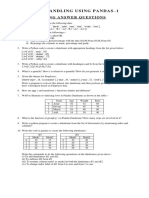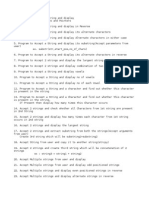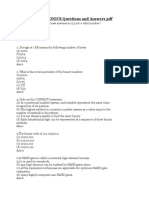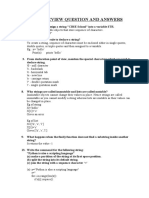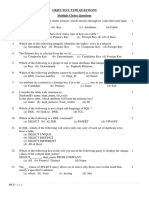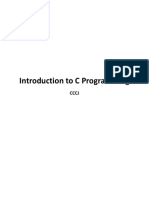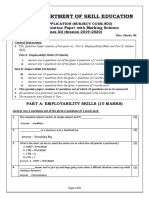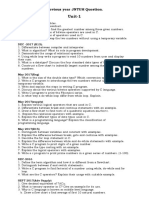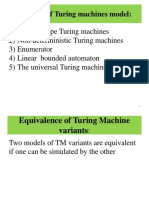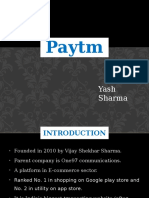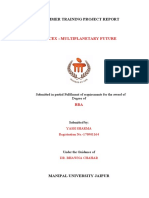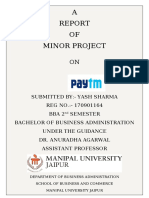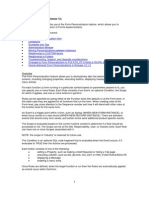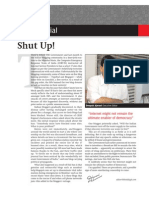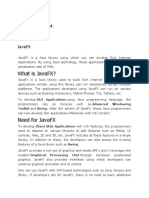Fundamentals of Computers: Reema Thareja
Fundamentals of Computers: Reema Thareja
Uploaded by
Yash SharmaCopyright:
Available Formats
Fundamentals of Computers: Reema Thareja
Fundamentals of Computers: Reema Thareja
Uploaded by
Yash SharmaOriginal Title
Copyright
Available Formats
Share this document
Did you find this document useful?
Is this content inappropriate?
Report this DocumentCopyright:
Available Formats
Fundamentals of Computers: Reema Thareja
Fundamentals of Computers: Reema Thareja
Uploaded by
Yash SharmaCopyright:
Available Formats
Fundamentals of
Computers
Reema Thareja
© Oxford University Press 2014. All rights reserved.
Chapter 4
Number Systems and
Computer Codes
© Oxford University Press 2014. All rights reserved.
Binary Number System
• Computers are electronic machines that use binary logic.
• This logic uses two different values to represent
the two voltage levels (value 0 for 0 V and value 1 for +5 V).
• The binary number system uses only two digits, 0 and 1.
© Oxford University Press 2014. All rights reserved.
Binary Number System
© Oxford University Press 2014. All rights reserved.
Converting Binary Number into Decimal Form
Convert (1101)2 into a decimal number
Decimal number = 1 × 23 + 1 × 22 + 0 × 21 + 1 × 20
=1×8+1×4+0×2+1×1
=8+4+0+1
= 13
© Oxford University Press 2014. All rights reserved.
Converting Decimal Number into Binary Form
Convert 169 into its binary equivalent
© Oxford University Press 2014. All rights reserved.
Adding Two Binary Numbers
Rules of Binary Addition
•0+0=0
•0+1=1
•1+0=1
• 1 + 1 = 0, and carry 1 to the next more significant bit
© Oxford University Press 2014. All rights reserved.
Adding Two Binary Numbers
Examples of Binary Addition
© Oxford University Press 2014. All rights reserved.
Subtracting Two Binary Numbers
Rules of Binary Subtraction
•0−0=0
•1−0=1
•1−1=0
• 0 − 1 = 1, and borrow 1 from the next more significant bit
© Oxford University Press 2014. All rights reserved.
Subtracting Two Binary Numbers
Examples of Binary Subtraction
© Oxford University Press 2014. All rights reserved.
Subtraction Using Two’s Complement
Calculate 1011 − 1001 using two’s complement
•Subtrahend = 1001
•One’s complement of subtrahend = 0110
•Two’s complement of subtrahend = 0110 + 1 = 0111
•Add the minuend and the two’s complement of the subtrahend
© Oxford University Press 2014. All rights reserved.
Multiplying Two Binary Numbers
Rules of Binary Multiplication
•0 × 0 = 0
•0 × 1 = 0
•1 × 0 = 0
•1 × 1 = 1
© Oxford University Press 2014. All rights reserved.
Multiplying Two Binary Numbers
Examples of Binary Multiplication
© Oxford University Press 2014. All rights reserved.
Dividing Two Binary Numbers
© Oxford University Press 2014. All rights reserved.
Octal Number System
• Base 8 number system which uses digits 0–7
• Extensively used in early mainframe computer systems
• Less popular in comparison to binary and hexadecimal systems
© Oxford University Press 2014. All rights reserved.
Converting Octal Number into Decimal Form
Convert (123)8 into its decimal equivalent
Decimal number = 1 × 82 + 2 × 81 + 3 × 80
= 1 × 64 + 2 × 8 + 3 × 1
= 64 + 16 + 3
= 83
© Oxford University Press 2014. All rights reserved.
Converting Decimal Number into Octal Form
Convert 9890 into octal form
© Oxford University Press 2014. All rights reserved.
Hexadecimal Number System
• Base 16 number system
• Symbols 0–9 represent values zero to nine, and A, B, C, D, E, F (or
a–f ) represent values 10–15
• Prefix 0x is used for numbers represented in hexadecimal system
© Oxford University Press 2014. All rights reserved.
Converting Hexadecimal Number into Decimal Form
Convert 0x312B into its equivalent decimal value
Decimal number = 3 × 163 + 1 × 162 + 2 × 161 + B × 160
= 3 × 4096 + 1 × 256 + 2 × 16 + B × 1
= 12288 + 256 + 32 + 11
= 12587
© Oxford University Press 2014. All rights reserved.
Converting Decimal Number into Hexadecimal Form
Convert 1239 into Hexadecimal Form
© Oxford University Press 2014. All rights reserved.
Converting Hexadecimal Number into Binary Form
• Write the 4-bit binary representation of each hexadecimal digit
• Convert 0xABCD into its binary equivalent
(ABCD) = (1010 1011 1100 1101)
16 2
© Oxford University Press 2014. All rights reserved.
Converting Binary Number into Hexadecimal Form
• Pad the binary number with leading zeroes (if necessary), so that it
contains multiples of 4 bits
• Convert the binary number 01101110010110 into its hexadecimal
equivalent
▪ After padding the binary number is 0001 1011 1001 0110
▪ Substitute the appropriate hexadecimal digits for a group of
four binary digits
▪ The equivalent hex number = 1B96
© Oxford University Press 2014. All rights reserved.
Converting Hexadecimal Number into Octal Form
• Convert the hexadecimal number into its binary equivalent
• Convert the binary number into its equivalent octal number
• Convert (A1E)16 into its octal equivalent
▪ Convert (A1E)16 into its binary equivalent (10100001
1110)2
▪ Now divide the binary number into groups of 3 binary
bits and convert each group into its equivalent octal
number. Thus, we have (5036)8
© Oxford University Press 2014. All rights reserved.
Converting Octal Number into Hexadecimal Form
• Convert the octal number into its binary equivalent
• Convert the binary number into hexadecimal form
• Convert (567)8 into its hexadecimal equivalent
▪ (567)8 = (101 110 111)2
▪ Form groups of 4 binary bits
▪ (Left pad if required) and convert each group into
hexadecimal number. Thus, we have (177)16
© Oxford University Press 2014. All rights reserved.
Working with Fractions
Convert (10110.1110)2 into decimal
(10110.1110)2 = 1 × 24 + 0 × 23 + 1 × 22 + 1 × 21 + 0 ×20 + 1 × 2−1
+ 1 × 2−2 + 1 × 2−3 + 0 × 2−4
= 1 × 16 + 0 × 8 + 1 × 4 + 1 × 2 + 0 × 1 +
1 × 1/2 + 1 × 1/4 + 1 × 1/8 + 0 × 1/16
= 16 + 0 + 4 + 2 + 0 + 0.5 + 0.25 + 0.125 + 0
= 22.875
© Oxford University Press 2014. All rights reserved.
Working with Fractions
Convert (127.35)8 into decimal
(127.35)8 = 1 × 82 + 2 × 81 + 7 × 80 + 3 × 8−1 + 5 × 8−2
= 1 × 64 + 2 × 8 + 7 × 1 + 3 × 1/8 + 5 × 1/64
= 64 + 16 + 7 + 0.375 + 0.078125
= 87.453125
© Oxford University Press 2014. All rights reserved.
Signed Number Representation
• Required to encode negative numbers in the binary
• Three widely used techniques are:
✓ In Sign-and-magnitude, MSB is set to 0 for a positive number
or zero, and set to 1 for a negative number. The other bits
denote the value or the magnitude of the number.
✓ In One’s Complement, first write the binary representation of
the number’s positive counterpart and then negate each bit.
✓ In Two’s Complement, negate all the bits in the binary
representation and then add 1 to the result.
© Oxford University Press 2014. All rights reserved.
BCD Code
• Used for encoding decimal numbers
• Digits 0-9 are used
• Each digit is represented by its own binary sequence of 4 bits
• For example, decimal 7 is 0111 in BCD
• Allows easy conversion to decimal digits for printing or display
• Allows faster decimal calculations
© Oxford University Press 2014. All rights reserved.
BCD Code
• Two types of BCD numbers are—unpacked and packed BCD
✓ In unpacked BCD representation, only one decimal digit is
represented per byte. The digit is stored in the lower
nibble, and the higher nibble is not relevant to the value of
the represented number. For example, Decimal 17 = 0000
0001 0000 0111.
✓ In packed BCD representation, two decimal digits are
stored in a single byte. For example, Decimal 17 = 0001
0111 (in BCD).
© Oxford University Press 2014. All rights reserved.
ASCII
• Stands for American Standard Code for Information Interchange
• Seven-bit character code
• ASCII characters are examples of unpacked BCD numbers
• Values in ASCII codes are represented as their 4-bit binary
equivalents stored in the lower nibble, while the upper nibble
contains 011
• Most common format for text files in computers and on the
Internet
© Oxford University Press 2014. All rights reserved.
EBCDIC
• Stands for Extended Binary Coded Decimal Interchange Code
• Eight-bit character-encoding technique used on mainframe
• Supports a wider range of control characters than ASCII
• EBCDIC characters are similar to ASCII characters. While the lower
nibble contains the 4-bit binary equivalent the upper nibble is
padded with 1111, instead of 011
© Oxford University Press 2014. All rights reserved.
Excess-3 Code
• Each decimal digit is the 4-bit binary equivalent with 3 (0011)
added
© Oxford University Press 2014. All rights reserved.
Gray Code
• A minimum change code, in which only 1 bit in the code changes
from one code to the next
• Non-weighted code
• Steps to obtain Gray code:
▪ Copy the MSB of the binary code as the MSB of the Gray
code
▪ Repetitively add MSB and the bit next to the MSB to get the
corresponding bit for the Gray code
© Oxford University Press 2014. All rights reserved.
Unicode
• Can represent characters (including punctuation marks,
mathematical symbols, technical symbols, and arrows) as integers
• Has several character encoding forms:
▪ UTF-8: Uses only 8 bits to encode English characters. This format is
widely used in email and on the Internet.
▪ UTF-16: Uses 16 bits to encode the most commonly used
characters. It can represent more than 65,000 characters.
▪ UTF-32: Uses 32 bits to encode the characters. It can represent
more than 100,000 characters.
© Oxford University Press 2014. All rights reserved.
You might also like
- 6th Central Pay Commission Salary CalculatorDocument15 pages6th Central Pay Commission Salary Calculatorrakhonde100% (436)
- CH 2 - Revision Tour 2 - Practice Material For Board ExamDocument31 pagesCH 2 - Revision Tour 2 - Practice Material For Board ExamMuhammed Nehan100% (1)
- PPS Important QuestionsDocument2 pagesPPS Important Questionspradeep100% (4)
- LAB#03: Assembly Language Programing Using Emu8086: TASK#01Document7 pagesLAB#03: Assembly Language Programing Using Emu8086: TASK#01Mohib Uddin100% (2)
- Problem Solving and C Programming Case Study Document For Hands-On v1.0Document13 pagesProblem Solving and C Programming Case Study Document For Hands-On v1.0flowerskrishna100% (2)
- C Language Notes PDFDocument88 pagesC Language Notes PDFShekhar ChanderNo ratings yet
- Data Handling Using Pandas-1: Long Answer QuestionsDocument1 pageData Handling Using Pandas-1: Long Answer Questionsvikas_2100% (1)
- C PRogramming Model Question PaperDocument2 pagesC PRogramming Model Question PaperNikhil Bhalerao100% (1)
- Data File Handling Application Based Questions AnswersDocument2 pagesData File Handling Application Based Questions AnswersDominic SavioNo ratings yet
- C Notes II-UNITDocument25 pagesC Notes II-UNITscet 315No ratings yet
- B.TECH. (Model Paper) : (Sem I) Theory Examination 2020-21 Programming For Problem SolvingDocument2 pagesB.TECH. (Model Paper) : (Sem I) Theory Examination 2020-21 Programming For Problem SolvingTushar SaxenaNo ratings yet
- Some Important Programs On Strings (In C)Document21 pagesSome Important Programs On Strings (In C)Anik80% (10)
- Ip Exam 2Document2 pagesIp Exam 2Yaishnave RNo ratings yet
- C Programming Interview Questions EduDocument23 pagesC Programming Interview Questions EdupoojaNo ratings yet
- CPDS Viva QuestionsDocument20 pagesCPDS Viva QuestionsUday Desiraj67% (6)
- The C Programming LanguageDocument22 pagesThe C Programming LanguageMobin HossainNo ratings yet
- Computer Graphics 2marksDocument12 pagesComputer Graphics 2marksArul Prakash67% (3)
- DIGITAL ELECTRONICS Questions and Answers PDFDocument5 pagesDIGITAL ELECTRONICS Questions and Answers PDFBryanOviedoNo ratings yet
- String Review Question and AnswersDocument2 pagesString Review Question and AnswersAarohi Sharma100% (1)
- Design of Absolute LoaderDocument3 pagesDesign of Absolute Loaderakbisoi160% (5)
- Me cp4212 Software Engineering ManualDocument34 pagesMe cp4212 Software Engineering ManualYasar BilalNo ratings yet
- Daa Lab Manual Program 2021-2022Document47 pagesDaa Lab Manual Program 2021-2022UMA SIKAMANINo ratings yet
- C Imp QuestionsDocument5 pagesC Imp Questionssatyanarayana1232No ratings yet
- Unit - 3 Values and Data Types: Computer Applications-Lorven Public School, ChanadapuraDocument22 pagesUnit - 3 Values and Data Types: Computer Applications-Lorven Public School, Chanadapuraks.ashwiniNo ratings yet
- C Debugging QuestionsDocument5 pagesC Debugging QuestionsRajesh VenkatachalamNo ratings yet
- User-Defined Methods: Class 10 - Logix Kips Icse Computer Applications With Bluej Multiple Choice QuestionsDocument10 pagesUser-Defined Methods: Class 10 - Logix Kips Icse Computer Applications With Bluej Multiple Choice QuestionsAyush PandeyNo ratings yet
- Design and Analysis of Algorithms: Question BankDocument7 pagesDesign and Analysis of Algorithms: Question BankDr-Pawan Singh KoriNo ratings yet
- Python Model Paper 2 Bplck105bDocument27 pagesPython Model Paper 2 Bplck105bHemanth CNo ratings yet
- C and Data Structures Unit Wise Important QuestionsDocument15 pagesC and Data Structures Unit Wise Important QuestionsToaster97100% (2)
- Model Question Paper Class-XI Computer Science M.M.:70 Time:3 HrsDocument19 pagesModel Question Paper Class-XI Computer Science M.M.:70 Time:3 HrsVikas SaxenaNo ratings yet
- Write 20 Simple Basic Python Programs With Output - SearchDocument4 pagesWrite 20 Simple Basic Python Programs With Output - Searchuplifter40No ratings yet
- C Language Tutorial For Beginners (With Notes) - CodeWithHarryDocument47 pagesC Language Tutorial For Beginners (With Notes) - CodeWithHarry60 - R - OP ChoudharyNo ratings yet
- Anna University CP 2 MarksDocument62 pagesAnna University CP 2 MarksKarthik S50% (2)
- QP XII Computer ScienceDocument11 pagesQP XII Computer Scienceyathavimokshitha9No ratings yet
- CS3251 Programming in C - IQ 1 - by WWW - Notesfree.inDocument7 pagesCS3251 Programming in C - IQ 1 - by WWW - Notesfree.inSuba Saravanan100% (1)
- Class XI Computer Science Holiday HDocument11 pagesClass XI Computer Science Holiday Hsofia guptaNo ratings yet
- EC6301-OOPs and Data Structures-Anna University-Question PapersDocument10 pagesEC6301-OOPs and Data Structures-Anna University-Question PapersbhuvangatesNo ratings yet
- C ProgrammingDocument62 pagesC Programmingabebaw ataleleNo ratings yet
- Grade 12 - Data Handling Using Pandas 1-Worksheet 3Document2 pagesGrade 12 - Data Handling Using Pandas 1-Worksheet 310B Zoya GousNo ratings yet
- 250+ C Programs For Practice PDFDocument13 pages250+ C Programs For Practice PDFrazi100% (1)
- Objective Type Questions Multiple Choice QuestionsDocument27 pagesObjective Type Questions Multiple Choice QuestionsManas Sachdeva VSIS100% (1)
- Goto Statement MCQ AnsDocument6 pagesGoto Statement MCQ Ansnancy_007No ratings yet
- C Programming - Lecture NotesDocument26 pagesC Programming - Lecture NotesbhdbkhqNo ratings yet
- CAEG Question Bank With SolutionsDocument24 pagesCAEG Question Bank With Solutionssksnjgaming100% (2)
- Cbse - Department of Skill Education: Sample Question Paper With Marking SchemeDocument9 pagesCbse - Department of Skill Education: Sample Question Paper With Marking SchemeAkshat GoyalNo ratings yet
- Unit-1: Previous Year JNTUH QuestionDocument2 pagesUnit-1: Previous Year JNTUH Questionnagarjuna100% (1)
- CPPS - Lab Manual (22POP13) (1-8)Document34 pagesCPPS - Lab Manual (22POP13) (1-8)Raghav V BhatNo ratings yet
- 1) Write A Program To Implement VRC and LRC. Code (VRC Program)Document9 pages1) Write A Program To Implement VRC and LRC. Code (VRC Program)Vaishali Amol KorgaonkarNo ratings yet
- Data Types in CDocument19 pagesData Types in CEr. Sunali Sharma100% (1)
- 18CSO106T Data Analysis Using Open Source Tool: Question BankDocument26 pages18CSO106T Data Analysis Using Open Source Tool: Question BankShivaditya singhNo ratings yet
- Programming in C: Reema TharejaDocument23 pagesProgramming in C: Reema Tharejakarunakaran100% (1)
- Pipeline and Vector ProcessingDocument18 pagesPipeline and Vector ProcessingPavan Pulicherla100% (1)
- Sample Question PapersDocument3 pagesSample Question Papersapi-372813678% (23)
- Intro C ManualDocument22 pagesIntro C ManualshilpaNo ratings yet
- Variants of Turing Machines ModelDocument38 pagesVariants of Turing Machines Modelsinto kumar royNo ratings yet
- Unit I Introduction: OCS752-Introduction To C Programming Department of CSE 2020-2021Document43 pagesUnit I Introduction: OCS752-Introduction To C Programming Department of CSE 2020-2021anitha gunasekaranNo ratings yet
- Previous Year Compiler Design Solved Gate Question by KanodiaDocument28 pagesPrevious Year Compiler Design Solved Gate Question by KanodiaBhardwajVaibhav100% (3)
- C Operator Questions With AnswersDocument12 pagesC Operator Questions With AnswersNachi AravindanNo ratings yet
- CH 2Document61 pagesCH 2Abdurehman DawudNo ratings yet
- Unit-1 Data RepresentationDocument57 pagesUnit-1 Data RepresentationPrinceNo ratings yet
- Fundamentals of Computers: Reema TharejaDocument47 pagesFundamentals of Computers: Reema TharejaYash SharmaNo ratings yet
- Fundamentals of Computers: Reema TharejaDocument39 pagesFundamentals of Computers: Reema TharejaYash SharmaNo ratings yet
- PaytmDocument7 pagesPaytmYash SharmaNo ratings yet
- Movie Review of The Harry Potter Series: A Project Report OnDocument16 pagesMovie Review of The Harry Potter Series: A Project Report OnYash SharmaNo ratings yet
- Space Exploration Technologies CorporationDocument35 pagesSpace Exploration Technologies CorporationYash SharmaNo ratings yet
- A OF Minor ProjectDocument44 pagesA OF Minor ProjectYash SharmaNo ratings yet
- Oracle Release 12+ Forms PersonalizationDocument18 pagesOracle Release 12+ Forms PersonalizationamoussaaNo ratings yet
- Create Reports Using JasperSoft Studio - IDempiere enDocument3 pagesCreate Reports Using JasperSoft Studio - IDempiere enWilson Gayo0% (1)
- Computer Department: Rizal Technological University College of Engineering and Industrial TechnologyDocument2 pagesComputer Department: Rizal Technological University College of Engineering and Industrial TechnologyMichaelAngeloDelaCruzNo ratings yet
- Use Sqlite002Document4 pagesUse Sqlite002eliseo fuertesNo ratings yet
- SQ. 0202.00 - SQ - CK-ID - IV - 2024 - PT. Asianet Media Teknologi (ACS Workload) Rev4Document1 pageSQ. 0202.00 - SQ - CK-ID - IV - 2024 - PT. Asianet Media Teknologi (ACS Workload) Rev4lewimmanuelNo ratings yet
- Sapscript Example ReportDocument8 pagesSapscript Example Reportsanjeevpandey2012No ratings yet
- Netscaler: The World'S Most Advanced Cloud Network PlatformDocument24 pagesNetscaler: The World'S Most Advanced Cloud Network PlatformMujahid PashaNo ratings yet
- AugDocument97 pagesAugAnonymous 9ufCY3No ratings yet
- PLC Programming Course1 KMXDocument55 pagesPLC Programming Course1 KMXtitohemanNo ratings yet
- Arkadios - Constrained Genericity For Borland DelphiDocument12 pagesArkadios - Constrained Genericity For Borland Delphijohnny-walkerNo ratings yet
- Working With HTML5 and CSSDocument18 pagesWorking With HTML5 and CSSTybca077Goyani VaidehiNo ratings yet
- NDNDNDNDDocument67 pagesNDNDNDNDSebastian HernandezNo ratings yet
- RefmanDocument2,241 pagesRefmanBenny LangstonNo ratings yet
- 2GCS213011B0050 - RVT Communication With Modbus RTU, Modbus TCP and PQ LinkDocument82 pages2GCS213011B0050 - RVT Communication With Modbus RTU, Modbus TCP and PQ Linkrichar berrocal orellanaNo ratings yet
- Overload Monitoring System in Public TransportationDocument41 pagesOverload Monitoring System in Public Transportationda100% (4)
- Data Stack Requirements in A Microservices World SlideDocument30 pagesData Stack Requirements in A Microservices World SlideJOAQUIN ENRIQUE LEALNo ratings yet
- Useful Function Keys and ShortcutsDocument2 pagesUseful Function Keys and ShortcutsLucianNo ratings yet
- NewsDocument145 pagesNewsPratap BarreNo ratings yet
- Sequential Circuit Description: Unit 5Document76 pagesSequential Circuit Description: Unit 5ramjidr100% (1)
- X-WSG Quick Setup Guide: RegistrationDocument5 pagesX-WSG Quick Setup Guide: RegistrationJorge GimenezNo ratings yet
- Ebs LoginDocument3 pagesEbs LoginAmir RiazNo ratings yet
- TS 480HXDocument8 pagesTS 480HXRichard Manuel Movil CujiaNo ratings yet
- The NizamDocument443 pagesThe NizamNaveen Reddy KamaniNo ratings yet
- Python Ratan CompleteMaterialDocument306 pagesPython Ratan CompleteMaterialDhanushekar NNo ratings yet
- Intern ReportDocument40 pagesIntern ReportShadowz SK100% (1)
- Digital Controller Design To Mitigate Chaotic Vibrations in Magnetic Levitation SystemDocument1 pageDigital Controller Design To Mitigate Chaotic Vibrations in Magnetic Levitation SystemUsama KhalidNo ratings yet
- What Is Pega? 2. Why Should We Use Pega? 3. What Are The Teams Are Used To Develop An Application?Document3 pagesWhat Is Pega? 2. Why Should We Use Pega? 3. What Are The Teams Are Used To Develop An Application?Salman ShaikNo ratings yet
- Network Planning and Design Is An Iterative Process, Encompassing TopologicalDocument17 pagesNetwork Planning and Design Is An Iterative Process, Encompassing TopologicalvishantbatraNo ratings yet
- Hw2 SolutionDocument8 pagesHw2 SolutionTun LeNo ratings yet
- Technologies Used JavaFx MysqlDocument31 pagesTechnologies Used JavaFx MysqlAIMEN NAAZ SHAHEENNo ratings yet






